MyDigitalSSD SMART & BP3 mSATA SSD Review
by Kristian Vättö on January 22, 2013 1:24 PM ESTRandom Read/Write Speed
The four corners of SSD performance are as follows: random read, random write, sequential read and sequential write speed. Random accesses are generally small in size, while sequential accesses tend to be larger and thus we have the four Iometer tests we use in all of our reviews.
Our first test writes 4KB in a completely random pattern over an 8GB space of the drive to simulate the sort of random access that you'd see on an OS drive (even this is more stressful than a normal desktop user would see). I perform three concurrent IOs and run the test for 3 minutes. The results reported are in average MB/s over the entire time. We use both standard pseudo randomly generated data for each write as well as fully random data to show you both the maximum and minimum performance offered by SandForce based drives in these tests. The average performance of SF drives will likely be somewhere in between the two values for each drive you see in the graphs. For an understanding of why this matters, read our original SandForce article.
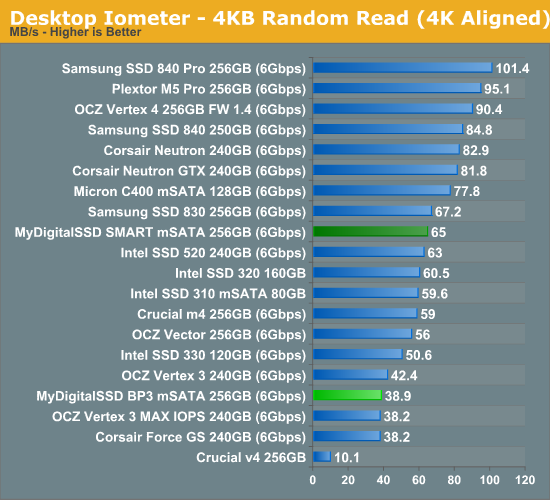
Compared to the PS3105 based Crucial v4, the BP3 offers a significant improvement in random read performance. It's still nowhere close to the fastest SATA 6Gbps drives, but at least the performance is no longer horrible. As for the SMART, its random read performance is similar to other SF-2281 based SSDs, as expected.
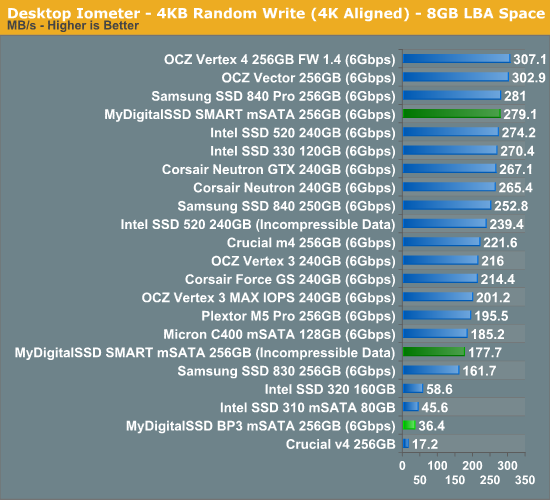
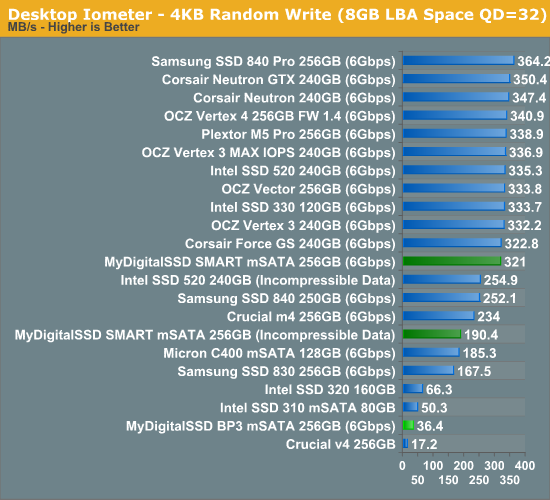
Random write speed is still the Achilles' Heel of Phison, though. The PS3108 is able to offer twice the performance of PS3105, but 36.4MB/s is still far slower than what most controllers are able to offer today. What's interesting is the fact that random write performance does not scale up at all when queue depth is increased—usually the throughput increases as the queue depth goes up as you can see in the graphs above.
Sequential Read/Write Speed
To measure sequential performance I ran a 1 minute long 128KB sequential test over the entire span of the drive at a queue depth of 1. The results reported are in average MB/s over the entire test length.
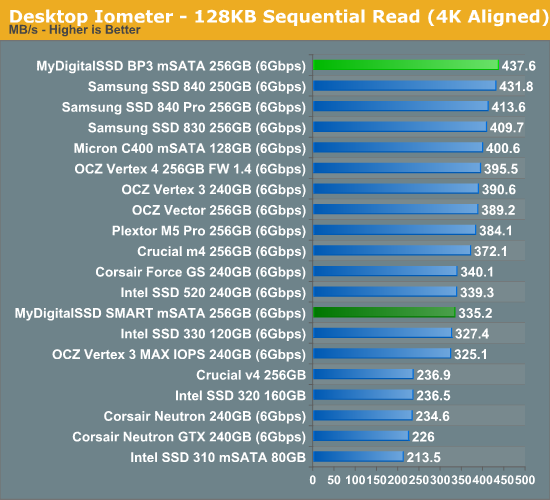
Similar to the Crucial v4, the BP3 has strong sequential performance. SMART's performance characteristics are once again typical SandForce, no surprises here.
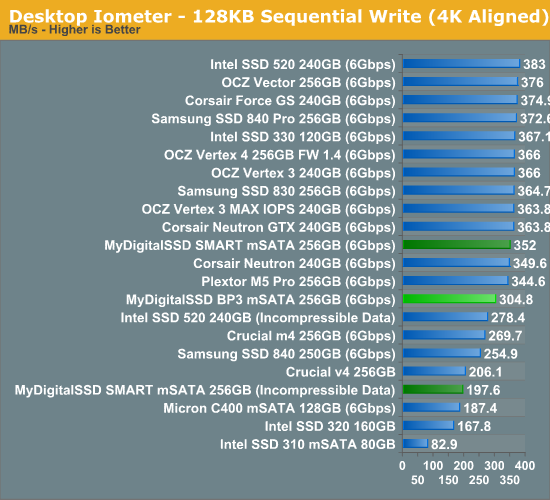
AS-SSD Incompressible Sequential Performance
The AS-SSD sequential benchmark uses incompressible data for all of its transfers. The result is a pretty big reduction in sequential write speed on SandForce based controllers, while other drives continue to work at roughly the same speed as with compressible data.
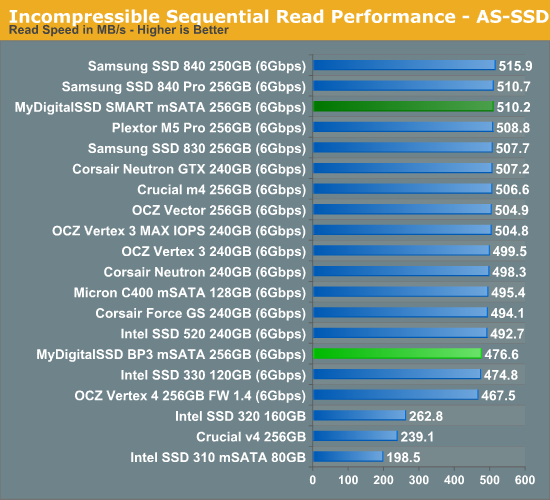
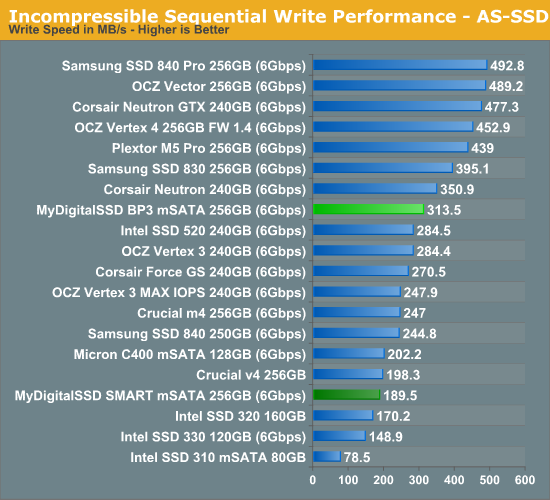










49 Comments
View All Comments
nathanddrews - Friday, January 25, 2013 - link
I have a JMicron-based G.SKILL FM-25S2S-64GB sitting around doing nothing. It has a USB port so I sometimes use it as a thumb drive. I am more than happy to donate it to the cause. Just tell me where to send it.Kristian Vättö - Saturday, January 26, 2013 - link
I bet sending the drive to Finland will cost more than the drive itself ;-) Anand should have some older SSDs, so I'll ask if he could run some testsnathanddrews - Saturday, January 26, 2013 - link
I just checked estimates from FedEx and UPS... You are not kidding! I thought it would cost about $25, not $125.Anand lives in southern USA, doesn't he? That should be very cheap. If he doesn't have one of these kickass drives, I'll send it to him. ;-)
Kristian Vättö - Saturday, January 26, 2013 - link
Anand lives in Raleigh, North Carolina. He still has JMicron based drives (just asked him) and he'll run some tests once he finds one, so no need to send one :-)nathanddrews - Saturday, January 26, 2013 - link
Cool, can't wait to see the results. Thanks, Kristian!Per Hansson - Thursday, January 31, 2013 - link
That's nice Kristian!I'm looking forward to seeing those results :)
Tjalve - Tuesday, April 9, 2013 - link
Ive actually done some testing on performance consistency for my reviews over att Nordichardware.sehttp://www.nordichardware.se/SSD-Recensioner/svens...
Theese tests are NOT done on a steady state drive though. But theese nuymbers give an indication on how I/O Latency are reflected i a real-world situation.
AND the graphs include some crappy drives like the Verbatim SSD 128GB and the Teamgroup L2 128GB.
I actually have steady state 4K Write perormance numbers (similiar to the ones here) on most drives aswell, but i havet published them just yet.
Gunbuster - Tuesday, January 22, 2013 - link
Workstation laptops. Going mSATA for OS often leaves you two other spindles for large spinning storage, another SSD or a combo of both.Why? For Hyper-V devs or content creators.
madmilk - Tuesday, January 22, 2013 - link
Workstation laptops and DIY upgrading is quite a niche scenario. Most workstation owners (that is, businesses) would just build-to-order with the SSD, instead of risking downtime just to save a couple hundred bucks.critical_ - Tuesday, January 22, 2013 - link
I own a Dell M6700 with the ADATA SX300 mSATA SSD (256GB) and 3 Hitachi 7200RPM 2.5" 1TB drives in RAID5. While I'd like to think I'm the only person in the world with this configuration, that would be silliness on my part. :)